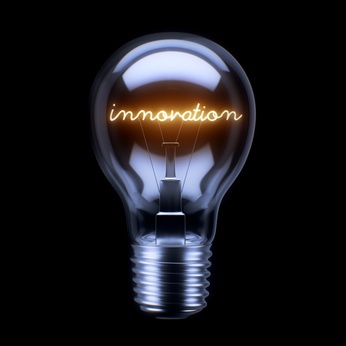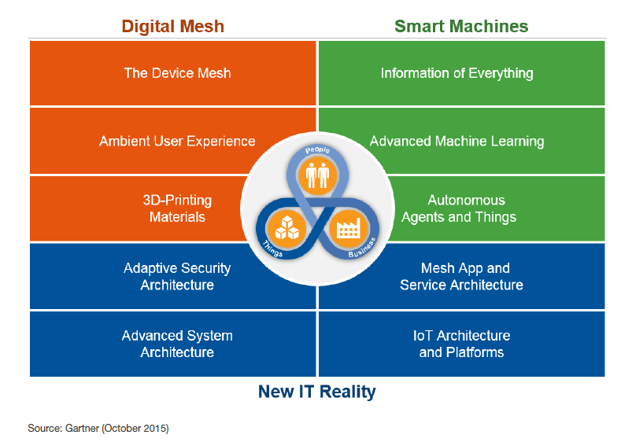Present Blog – IT Thought Leadership
Blog Present-IT thought leadership
Blog Present-IT thought leadership
IT thought leadership blog for CIOs and CTOs in Canada seeking resources to drive IT as a business contributor: hybrid cloud, infrastructure, managed services and security and IT recruitment.
 New technology trends have increasingly had major repercussions at the individual level of IT departments and businesses.
New technology trends have increasingly had major repercussions at the individual level of IT departments and businesses.
If the implications of these trends may seem distant for many Canadian business leaders, they should nevertheless be taken into account to allow the evolution of both the organization and the business models in the context of current digital transformation.
The latest research by Gartner, on key technologies for 2016 classifies 10 trends in 3 categories.

1. The digital mesh
This is a set of technologies that continuously extends to deliver dynamic connections between individuals, connected devices, sensors, applications, services and businesses. Today and in the coming years, IT development will focus on the creation and expansion of this digital mesh around businesses, organizations and individuals.
Trend 1: The mesh devices
To build the digital mesh, refers to a device mesh, an expanding set of endpoints people use to access applications and information; devices are essential because they are the points of access to information and allow interactions. In addition to computers, tablets and smartphones, the grid extends through connected devices and other sensors.
Gain for companies: the mesh can create "living" ecosystems that improve both business processes and relationship with customers.
Trend 2: Ambient customer experience
While traditionally the customer experience was a set of ad hoc interactions unrelated to each other, the Internet and mobile technologies unify interactions today. Digital networking brings it even further as the customer experience becomes omnipresent.
Gain for companies: it is possible to create an immersive customer experience in an augmented reality in order to keep more customers captivated.
Trend 3: 3D printing materials
3D printing will continue to experience major advances because of the variety of materials that can now be used (carbon fiber, conductive inks, glass or organic materials).
Gain for business: innovation opportunities in industries such as aeronautical, biomedical, automotive, military are just some of the endless possibilities available to companies. You should also take into consideration, gains for the supply chain.
2. Smart machines
Instead of traditional machines that exist to perform prescribed actions, the revolution of intelligent machines has seen the emergence of systems designed to adapt and learn to increase their capacity.
Trend 4: Information of Everything (IoE)
This trend is based on the principle that data is everywhere in unstructured form and structured data is more easily exploitable.
Gain for business: making sense of the data to extract value and use in the enterprise ecosystem.
Trend 5: Machines that understand
New models are created to infuse more intelligence in systems. This is the next step in the analysis and operation of machinery, to enable them to "understand" the environment and be more independent.
Gain for business: Intelligent machines can allow enterprises to obtain competitive gains by identifying trends before others.
Trend 6: Agents and autonomous objects
These include all the robots, UAVs, autonomous vehicles and other smart alarms that act in complete autonomy. Siri and Cortana systems fall into this category of agents. They can become advanced interfaces between many applications.
Gain for companies: these agents should be exploited to liberate people from mundane tasks that are only made by humans, although they have low added value.
3. The new IT reality
This theme is the foundation that supports intelligent machines and digital networking because it covers architectures and platforms that make the development of two other aspects possible. The new IT value chain begins at the structure.
Trend 7: Adaptive security architecture
Ensuring the security of systems and businesses is becoming increasingly complex because of the Internet of Things, mobility, cloud and the hacking industry. Adaptive Security Architecture looks beyond perimeter defense, IT leaders must now adopt and create applications that can protect itself and analyze behavior to protect against faults and to mitigate risk.
Gain for business: as businesses and individuals depend more and more on technology, we must ensure internal security, and also offer solutions that enable customers to protect their privacy.
Trend 8: Advanced Systems Architecture
This type of architecture has to allow the computing capacity required by intelligent agents and other digital mesh machines. For example, facial recognition applications rely on many combinations of algorithms that consume large computing capabilities that are enhanced by advanced systems.
Gain for Business: provide faster applications that consume less resources and energy.
Trend 9: Application mesh architecture is service
This emerging trend is characterized by a unified model to build micro services linked by applications available on various devices. It’s about building systems that are able to adapt to user needs as they evolve.
Gain for companies: to create a continuous digital experience on all platforms.
Trend 10: Architecture and platform for the Internet of Things
The integration of all components of the architecture for the Internet of Things is still a puzzle and will remain so over the coming years. While industry leaders such as IBM, Oracle or SAP begin to provide elements for these platforms to be linked with the user interface, IT leaders must still create their architecture and be creative with the integration.
Gain for companies: the best use of the Internet of Things through a performance platform and architecture.
Conclusion
To establish your digital transformation strategy, it is important to take these trends into account, as they are key to your successful transformation. Present conducted a study to help Canadian companies in their digital transformation. Request your free consultation to map out the foundation for your strategy.
Photo credit: © xtock - Fotolia.com
About Blog
The right use of technology addresses business challenges and drives business growth in all areas of an enterprise. We hope this blog will offer insight into developing strategies and tactics to enable you to identify those key drivers of growth and keep pace with and anticipate the rapid technology change of today.
Posts by Topic
- IT infrastructure (116)
- IT security (92)
- IT Innovation (59)
- Trends (51)
- Cloud (47)
- Managed services (46)
- Mobility (38)
- Digital transformation (29)
- CIO/IT leaders (28)
- Events (28)
- News (23)
- Microsoft 365 (17)
- Security (17)
- IBM (16)
- Disaster recovery (DR) (14)
- High availability (12)
- Recruitment (12)
- Storage (12)
- Big Data (11)
- Collaboration (11)
- AI (9)
- Case study (9)
- Office 365 (9)
- BYOD (8)
- Customer Experience (8)
- Hybrid Cloud (7)
- Current events (6)
- SAP Hana (5)
- Business intelligence (BI) (4)
- Converged infrastructure (4)
- Convergence / Hyper-convergence (4)
- Virtualization (4)
- Copilot (3)
- Future of retail (2)
- Retail (2)
- trend (2)
- Backups (1)
- Beacon (1)
- Blog Migrations (1)
- Contests (1)
- Infrastructure TI (1)
- Innovation TI (1)
- IoT (1)
- MDM (1)
- Stockage (1)
- Virtualisation (1)
- blockchain (1)
- cio (1)
- replication (1)
- Étude de cas (1)

